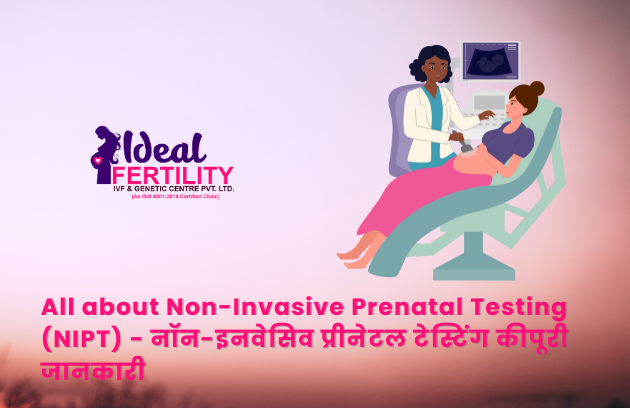Table of Contents
Non-Invasive Prenatal Testing (NIPT) [नॉन-इनवेसिव प्रीनेटल टेस्टिंग] is one of the most significant advancements in prenatal screening (प्रसवपूर्व जांच). It uses cell-free fetal DNA (भ्रूण डीएनए) circulating in the mother’s blood to screen for genetic conditions early in pregnancy. This test, now offered in many fetal medicine units (फीटल मेडिसिन यूनिट) across India, provides expectant parents with important insights- without the risks of invasive procedures.
What Is NIPT? The Role of Cell-Free Fetal DNA (भ्रूण डीएनए) in Modern Prenatal Care
NIPT is a type of prenatal genetic screening (प्रीनेटल जेनेटिक स्क्रीनिंग) that checks for chromosomal conditions like:
- Trisomy 21 (Down syndrome)
- Trisomy 18 (Edwards syndrome)
- Trisomy 13 (Patau syndrome)
- Sex chromosome anomalies
The test uses a simple blood sample from the pregnant woman. Inside this blood, small fragments of fetal DNA [भ्रूण डीएनए] are present originating from the placenta. These fragments are then analyzed using high-tech lab processes.

Unlike amniocentesis or chorionic villus sampling (CVS), this method carries no risk of miscarriage. That’s why it’s labeled non-invasive fetal testing (गैर-आक्रामक भ्रूण परीक्षण) and is increasingly used as a first-line screening tool in advanced clinics.
Is NIPT Right for You? Benefits, Limitations and Considerations (एनआईपीटी आपके लिए उपयुक्त है या नहीं?)
Doctors in fetal medicine units (फीटल मेडिसिन यूनिट) usually suggest it for:
- Women over 35.
- Pregnancies via IVF.
- Previous chromosomal abnormalities.
- Abnormal ultrasound or traditional test results.
Benefits of NIPT (एनआईपीटी के लाभ):
- Performed as early as 10 weeks.
- No physical risk to the fetus.
- Higher accuracy than traditional blood screening.
- Fewer false positives.
Limitations to Consider (सीमाएं):
- It is a screening, not a diagnostic test.
- It cannot detect all genetic disorders.
- Accuracy may reduce in cases like high maternal weight or twin pregnancies.
- May require confirmation with invasive tests if results are positive.
NIPT vs. Traditional Screening: Comparing Accuracy and Risk
When comparing non-invasive prenatal testing (नॉन-इनवेसिव प्रीनेटल टेस्टिंग) with older methods like the first-trimester combined screening, the difference is significant.
| Feature | Traditional Screening (पारंपरिक जांच) | NIPT (एनआईपीटी) |
| Performed | 11–14 weeks | From 10 weeks |
| Accuracy for Down Syndrome | ~85% | >99% |
| Invasiveness | May lead to invasive follow-up tests | Non-invasive |
| Risk of Miscarriage | Slight (if invasive follow-up needed) | None |
| Result Clarity | Moderate | High |
While traditional tests are useful, they are less accurate and may lead to unnecessary follow-up procedures. NIPT offers greater intervention methods.
The Science Behind NIPT: How Fetal DNA (भ्रूण डीएनए) in Maternal Blood Is Analyzed
The science of fetal diagnostic methods (भ्रूण निदान विधियाँ) has come a long way. NIPT uses next-generation sequencing to analyze fetal DNA found in the mother’s bloodstream.
Here’s how it works?
- A blood sample is taken from the pregnant woman.
- DNA is extracted from the plasma.
- Lab technology detects abnormal chromosome numbers.
- Results are interpreted by specialists in fetal diagnosis (फीटल डायग्नोसिस).
- Reports are usually available within 7 to 10 days.
This method avoids the complications associated with older invasive tests and fits perfectly into today’s patient-friendly prenatal screening (प्रसवपूर्व जांच) models.
Conclusion
Non-Invasive Prenatal Testing (NIPT) represents one of the most reliable advancements in prenatal screening. By analyzing cell-free fetal DNA, it provides early insights into the baby’s genetic health- without the risks of invasive procedures.
Whether you’re just learning about Prenatal Screening (प्रीनेटल स्क्रीनिंग) or actively considering your options, NIPT can offer clarity, confidence and peace of mind. As part of a complete prenatal plan- guided by your healthcare provider- it ensures you’re making informed, empowered decisions for your growing family.

